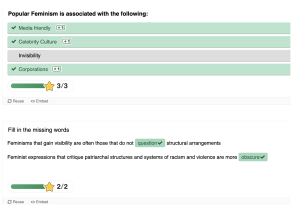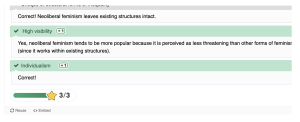3
Section One: The Fundamentals
A) Keywords
Exercise 1:
Briefly (in 100 words or less) define one of the keywords in the padlet (including one that you. may have added yourself).
| Misogynoir is a term introduced by Moya Bailey that describes the specific form of discrimination faced by Black women, where racism and misogyny intersect. It highlights how Black women are specifically marginalized in ways that differ from other women of colour. In sports, misogynoir manifests in media portrayals that scrutinize and minimize Black women athletes’ achievements while exaggerating their controversies. Examples include the treatment of Serena Williams and Naomi Osaka, where racial and gender biases shape public narratives. Misogynoir exposes how Black women’s experiences cannot be understood solely through racism or sexism but through their combined effects. |
B) Representing Race
Exercise 2: Notebook Prompt
In about 50-70 words, consider Joel Bervell’s question: why do we feel the need to extrapolate the athleticism of one Black athlete to all Black people when we do not do the same for white athletes?
Try to think of examples when this happens, making sure to reflect on your own positionality.
| The stereotype of Black athletes as naturally superior is rooted in racial biases that reduce their success to genetics rather than effort, training, or strategy. For example, Usain Bolt’s speed was often attributed to supposed genetic advantages, while Michael Phelps’ dominance in swimming was credited to coaching and discipline. This reflects a broader societal tendency to essentialize Black talent while allowing white athletes individual recognition. My own awareness of this bias comes from seeing how Black athletes’ achievements are often framed as instinctive rather than earned, reinforcing harmful racial myths and downplaying their hard work. |
C) Gender, Race & Sport
Exercise 3: Notebook Prompt
What are some strategies for resistance that Rajack and Joseph identify in their article as a means of pushing back against and resisting misogynoir?
| Rajack and Joseph identify several strategies of resistance against misogynoir in women’s sports media, focusing on how Black women athletes challenge their erasure, misrepresentation, and systemic marginalization. One key strategy is self-representation and media engagement, where athletes use their platforms to control their own narratives. Serena Williams, for instance, has spoken openly about the racism and sexism she faces, refusing to be silenced by mainstream media’s biased portrayals.
Another strategy is collective activism and solidarity among women athletes, as demonstrated by the WNBA’s coordinated protests supporting Black Lives Matter. WNBA players continued to speak out for racial and gender justice despite financial penalties leveled against them by the league, an incredible example that collective action can force conversations that organizations attempt to suppress. Other forms include resistance through insistence on visibility and challenging colorism. For example, mixed-race athletes, such as Naomi Osaka, have their Black identities downplayed or erased in most media discourses. Resisting such erasure, some come out publicly with their racial and cultural identities. For example, Osaka claimed her Haitian heritage because the media framed her as just Japanese. Challenging the stereotypes is critical, a frequent example of stereotyping facing Black women athletes is the “angry Black woman” trope, which was discussed in the backlash against Williams’ response to the 2018 US Open final. By addressing these double standards and demanding fair treatment, they expose the biases shaping public perception. Lastly, cultural and artistic representation brings awareness to misogynoir because one can document and critique these injustices in literature, media, and activism. |
Section Two: Making Connections
A) Athlete Activism
Exercise 3: Padlet Prompt
Do athletes have a responsibility to use their platform for social change? Why or why not? Please remember to record your response in both the padlet below and in your Notebook.
I believe Athletes hold a unique and influential position in society, making their voices powerful tools for social change. While they are not obligated to engage in activism, they do have a responsibility to use their platforms ethically. In the past, figures like Muhammad Ali, Colin Kaepernick, and Serena Williams have shown just how athletes can challenge racism, gender inequality, and other systemic issues through protest and advocacy.
Sports are seen to be apolitical, but this is an unrealistic expectation, as athletes exist within broader social structures that impact their lives. Ignoring injustices, such as racial discrimination in sports leadership or pay disparities in women’s sports, serves only to further embed them. An example is LeBron James, who leverages his platform to push for education equity and racial justice, this shows that athletes can make a difference.
On the other hand, some say that all athletes should stay away from politics and only compete to maintain neutrality. However, this is again one of the double standards never placed upon a white athlete or one who comes across as fighting for a popular cause.
Ultimately, no athlete is forced to be an activist, but their platform provides one of those rare opportunities to advocate for marginalized communities. Their actions have given way to inspire fans, to challenge repressive systems, and to further a larger cause of justice. Understanding the history of activism by athletes goes beyond a game. They can be among the changes of reform.
B) Athlete Activism & Feminism
Exercise 4: Complete the activities



Exercise 5: Notebook Prompt
What do the authors of the article call for as a way of challenging how mainstream sports journalism privileges neoliberal feminist concerns? (100 words max.)
| Cooky and Antunovic call for a shift away from neoliberal feminism, which emphasizes individual empowerment and visibility, toward a more intersectional and structural approach in sports journalism. They say that the mainstream media tend to emphasize viable feminist stories, such as equal pay for elite women athletes, while ignoring activism that calls out systemic inequalities, including racism and gender-based violence. The authors call for feminist storytelling that centers the voices of the marginalized, criticizes patriarchal and racialized power structures, and recognizes collective resistance over the celebration of success of an individual. This makes sure that the feminism within sports activism is not co-opted for corporate or superficial gains. |
C) Corporate social justice
Exercise 6: Padlet Poll
| In Favour:
I believe sports leagues have a responsibility to support social justice movements like Black Lives Matter (BLM) because of their large influence on culture and public discourse. Ramsey Khabbaz makes this point in Sports and Social Justice, though the NBA was highly supportive of BLM, as seen by the players’ taking a knee and messages of solidarity, the NFL suppressed activism at first, with its treatment of Colin Kaepernick. Staying neutral in these situations only maintain the current status quo. In movements such as that of BLM, leagues can work actively toward changing the system, making space where athletes can safely advocate for justice and building a fairer sports enviroment. |
Section Three: Taking a shot
Module Assignment (submit as part of notebook and separately through Blackboard mini assignment #1 portal)
In the television series Colin in Black & White (2021), Colin Kaepernick’s activism is explored through a deeply personal lens, illustrating the challenges and strategies he employed in speaking out against racial injustice. The show depicts Kaepernick’s transition from a rising football star to a vocal activist, particularly focusing on his decision to kneel during the national anthem in protest of police brutality. His approach was to use a nonviolent and symbolic protest, joining the longer history of Black athlete activism, including Muhammad Ali and Tommie Smith. At the same time, Colin in Black & White showcases how the sports industry, the NFL in particular, tried to silence his activism through blacklisting, a fact strengthening Ramsey Khabbaz’s contention in Sports and Social Justice that leagues have traditionally resisted activism unless it came with financial or political expediency.
The series critically examines the expectation that athletes should “shut up and play,” a sentiment echoed in the backlash Kaepernick received. This reflects the double standard in athlete activism, as Khabbaz contrasts the NBA’s support for BLM with the NFL’s initial resistance. The show’s representation of Kaepernick as both an athlete and an activist challenges the notion that sports are apolitical, reinforcing Cheryl Cooky and Dunja Antunovic’s critique of neoliberal feminism, which privileges safe, marketable activism over systemic critique.
Race is essential to this representation. Kaepernick, as a biracial Black man who was raised in a white household, struggles with his identity and the pressures placed upon him. His experience represents the concept of intersectionality, and his racial identity informs how his activism is perceived, while white athletes like Megan Rapinoe also knelt, the consequences for Kaepernick were far more severe. Ultimately, this represents sports as the site of empowered and racialized control, so that activism around athletics is being resisted precisely in its challenge to the power controlling sports and societies.

